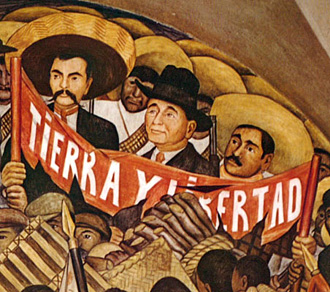
|  |  |  News Around the Republic of Mexico News Around the Republic of Mexico  
Revolution: Emiliano Zapata and the Agrarian Revolution
 Edgar Rojano - bicentenario.gob.mx Edgar Rojano - bicentenario.gob.mx
go to original
September 14, 2010

Never has there been a man more intimately linked to the history of his people than Emiliano Zapata.
- Jesús Sotelo Inclán


| | Mural by Diego Rivera in the National Palace |  |
Once, as Gabriel Zapata wept disconsolately over the loss of the lands belonging to the town of Anenecuilco to the “powerful masters” of the sugar plantations; his young son Emiliano, who witnessed the scene, swore that when he was big he would get the lands back. Not much time would pass before he fulfilled his promise.

Emiliano Zapata was born on August 8, 1879 in the town of Anenecuilco of Villa de Ayala. Very young, at the age of 30, he was elected by his neighbors to represent them in defending the town’s lands that, like so many others in the state of Morelos, were threatened by the voraciousness of the sugar plantations.

Miliano, as he was affectionately called, belonged to a family whose roots could be traced back to the war of Mexican independence. He had personally contributed to resolving his community’s problems, and he sympathized with the political opposition in Morelos. He owned a few hectares that he worked himself. He liked horses. An Englishwoman, Rosa King, owner of the Buena Vista Hotel in Cuernavaca, knew Zapata personally and remembers that “he had the swarthy complexion common to the men of Cuautla, and beneath his thick, black mustache shone some beautiful, white teeth. He dressed in the cowboy clothes the ranchers used; they were always well kept […]”

Zapata soon had to act. In mid 1910, the owners of the Hacienda del Hospital refused to allow their lands to be planted for the season, and Zapata decided it was time to distribute the land. The farm workers’ interests soon coincided with Francisco Ignacio Madero’s call for “Effective suffrage. No reelection.” During the Villa de Ayala fair in March 1911, Pablo Torres Burgos, Rafael Merino and Emiliano Zapata rebelled, which led to a series of uprisings in various parts of the state. The farm workers of Morelos were hopeful that joining with Madero’s movement would lead to fulfillment of the San Luis Plan, which called for returning the land that had been taken so arbitrarily from its former owners. But Madero’s promise never materialized, and Zapata distanced his movement from that of Madero.

Madero, the democrat, became in the eyes of Zapata’s followers (Zapatistas), a traitor to the Revolution. In order to reclaim their ideals, the Morelos revolutionaries drafted the Plan de Ayala on November 25, 1911, which summarized their aspirations:

| As an additional part of the plan that we invoke, we give notice that the fields, hills and waters that the landlords, científicos or bosses have usurped, the towns or citizens who have the titles corresponding to those properties will immediately enter into possession of that of which they have been despoiled by the bad faith of our oppressors, maintain at any cost with arms in hand the mentioned possession; and the usurpers who consider themselves with a right to (those properties) will deduce it before the special tribunals which will be established on the triumph of the revolution. |

From then on, the Plan de Ayala became the banner under which the Zapatistas fought successive revolutionary governments. Their tenacious defense of agrarian principles was incomprehensible to many people of that era, but evident to the farm workers, who felt deeply identified with their lands. General Zapata said this to Francisco Villa during their conversation in Xochimilco on December 4, 1914: “They feel a deep love for their lands. They still can’t believe it when they are told: This land is yours. They think it’s a dream. But when they have seen others harvesting crops on these lands, then they will also say: I’m going to ask for my land and I’m going to plant. The people love their land above all else. It is what sustains them, usually.”

During the zapatista utopia in Morelos, it was decreed that the towns had the right to freely elect their officials; municipal independence was decreed; and sugar mills were operated for the collective good. But most importantly, there was an attempt to redeem the indigenous peoples by returning their land, and therefore their freedom, to them. In the midst of the Revolution and adhering to their customs and their ways, the Zapatistas began to distribute parcels of land. The Revolution had begun to do them justice.

But times were difficult for their movement. In February 1917, a Constitutional Congress convoked by Venustiano Carranza promulgated a new Constitution with agrarian reforms. At the same time, the revolutionaries of Morelos had become isolated and militarily weak.

In this context, General Emiliano Zapata was asked by Jesús Guajardo, a colonel who fought under Carranza’s General Pablo González, to join him. Zapata accepted and, to seal the pact, they decided to meet at the Chinameca hacienda on April 10, 1919. The story of the betrayal is harrowing: “The bugle blew three times. As the last note faded, the General in Chief walked through the doorway […] Guajardo’s soldiers fired two volleys at point blank range and our unforgettable General Zapata fell, to get up no more.”

The news spread like wildfire, and despite the fact that his corpse was exhibited in Cuautla’s town hall, the Zapatistas were incredulous, refusing to believe that they had lost a member of their family. To this day, says the legend, it is known that Zapata did not die, that a friend took him to Arabia, where he still can be seen, a dream of history, riding his horse.
|

 |
|  |



